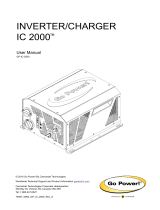
TWO YEAR LIMITED WARRANTY
Limited Warranty and Remedy
:
(
“Supplier”) warrants products it sells against faulty
workmanship or the use of defective materials and that such products will conform to published specifications, drawings
and other descriptions for a period of two years.
This warranty is the only warranty made by Supplier and is in lieu of all other warranties, express or implied, except as to
title, and can be amended only by a written instrument signed by an officer of Supplier.
The liability of Supplier under this warranty is limited solely to replacing, repairing or, at Supplier's discretion, issuing credit
for any devices which are returned by Buyer during the schedule period, provided that (a) Supplier is promptly notified in
writing upon discovery of any defect by Buyer with a detailed explanation of any alleged deficiencies; (b) the defective
product is returned to Supplier, transportation charges prepaid by Buyer; and (c) Supplier's examination of such product
discloses to its satisfaction that such defect was not caused by misuse, neglect, improper installation, repair, alteration or
accident. In no event shall Supplier be liable to Buyer for loss of profits, loss of use, or damages of any kind based upon a
claim for breach of warranty. All PowerMax products must be installed by a certified electrician.
GENERAL DISCLAIMER
In accordance with our policy of continuous product improvement, Supplier reserves the right to make changes or
improvements to the products and specifications at any time without prior notice. Prices are also subject to change without
notice.
Supplier makes every effort to ensure information provided in our technical literature is accurate and reliable. We cannot,
however, assume responsibility for inadvertent errors, inaccuracies, omissions or subsequent changes. We assume no
responsibility for the use of this information, and any and all such use of this information shall be entirely at the user's own
risk. No patent rights or licenses applicable to any of the products of Supplier’s intellectual property described herein are
granted to any third party, either directly or by implication, or any other means. Furthermore, despite efforts to ensure
otherwise, we make no representation that the information and/or circuitry described herein is free of infringement on any
intellectual property rights or any other rights of third parties.
LIMITATION ON THE USE OF PRODUCTS
Products are not designed for and should not be used in any life-support systems, nuclear facility applications, aircraft
control applications, or any other applications in which failure of the product, in any way, could reasonably result in harm
to life, property or the environment, without the specific prior written consent of an officer of Supplier.
A life support system is defined as a product or system intended to support or sustain life and whose failure can be
reasonably expected to result in significant personal injury or death. Nuclear facility applications are defined as any
application involving a nuclear reactor or the handling and processing of radioactive materials in which the failure of
equipment, in any way, could reasonably result in harm to life, property or the environment.
Fieldstone Products PMB 103 • 11161 E SR 70 STE 110 • Lakewood Ranch, FL 34202
Phone: 941-201-8041 • Fax: 941-405-4930
www.powermaxconverters.com











